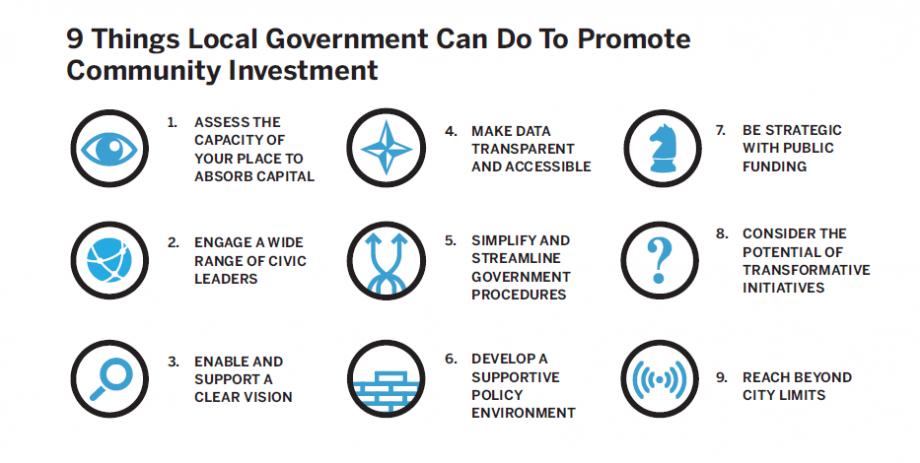This post originally appeared on The Catalyst, the house blog at Living Cities.
Cities across the nation are under financial pressure. They lack the public funds to create more opportunity by investing in economic development, human capital and physical infrastructure. Private capital could go a long way towards meeting these investment needs. Too often, available private capital cannot be put to work in our cities because the mechanisms to attract and deploy capital are not in place. It’s as though private capital is an airplane, circling overhead, without the landing strip or the air traffic control needed to touch down safely. Even in a time of scarce public sector resources, there are things that city leaders can do to help put capital to work in their communities.
The Public Sector’s Role
Our recent paper, “The Capital Absorption Capacity of Places: A Research Agenda and Framework,” considered how communities successfully and efficiently take investment capital and apply it to community development purposes. We are convinced that leadership from the public sector can make an enormous difference in creating the conditions that attract private capital and ensure it is utilized effectively to build sustainable and equitable communities. That is why we are releasing a new paper, “Putting Dollars to Work in the Community: 9 Things Local Government Can Do to Harness Private Capital for Public Good,” outlining some key steps for public sector officials to consider and providing examples of places that have implemented these steps. A resource list at the end of the paper suggests where to find more information.
Investments That Create Opportunity
City government can help mobilize private sector investment and channel it to important public purposes.
Increasing the flow of capital to build sustainable cities that offer opportunities to all residents — also known as community investment — has the potential to support economic development, augment the local tax base, revitalize neighborhoods and improve quality of life for all residents.
Community investment operates across a range of sectors, tied together by a common focus on underserved markets. Investors seeking to achieve social and economic impact may invest in affordable housing, energy efficiency retrofits, or neighborhood stabilization through foreclosure prevention. They may focus on investments in important facilities, such as community health clinics, childcare centers or grocery stores. They may invest in large scale economic development projects or lend to small businesses. Whatever the specific area, community investment creates both financial and social returns (a “double bottom line”) and is a form of impact investing.
Capital to achieve public purposes such as those described above can come from diverse sources. Financial institutions — ranging from local, regional and national banks and insurance companies to special purpose Community Development Financial Institutions are important sources of community investment, as are foundations. Investors from individuals to pension funds look for community investments that offer stable returns and social impact. In addition, real estate developers and institutions such as universities and hospitals often make significant investments in the community, and their resources can be mobilized to achieve a variety of worthwhile public purposes.
A number of critical conditions must exist to mobilize investments that benefit all residents of a city. There must be a coherent vision and set of goals that have been articulated and embraced by a broad array of public, private, and non-profit leaders. Cities need to create a supportive policy environment and use available public resources as strategically as possible. Data about community needs should be collected and made widely accessible. Ongoing platforms for collaboration across sectors should be developed. Community stakeholders should be deeply engaged. Financial intermediaries able to assemble and deploy capital from a variety of sources should be identified and supported. Although the work of community investment requires the participation of many stakeholders, local government has a particularly important role to play.
What follows in our new report are tips on how local government can best promote effective community investment. They focus on the functions we believe are most suited to local government: Convening stakeholders, providing information, setting policy and investing public dollars. Not every suggestion will apply to every place, but taken together, they offer a set of actions that the public sector can take to build capacity, expand resources and achieve vital public goals more effectively.
Robin Hacke is director of capital formation at Living Cities. David Wood is director of the Initiative for Responsible Investment at Harvard University.




_600_350_80_s_c1.jpg)











